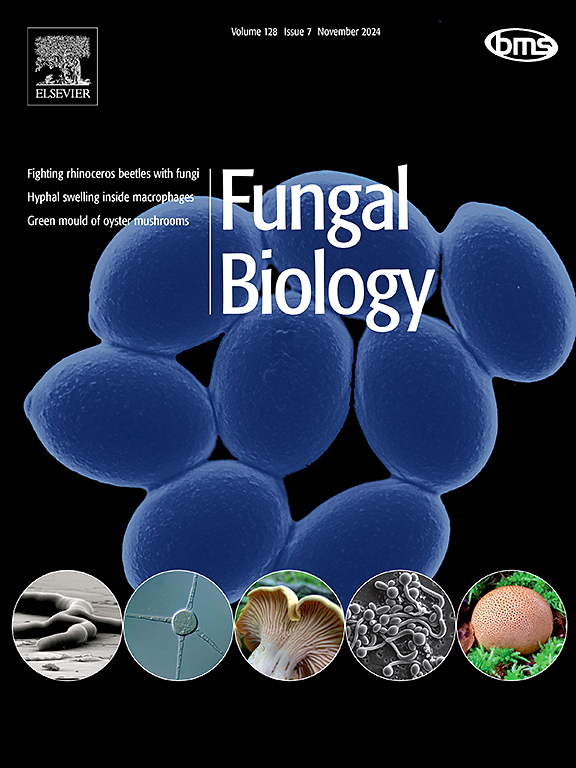通过科扎克优化的 2A 肽多基因表达系统提高青霉中霉酚酸的产量
IF 2.9
3区 生物学
Q2 MYCOLOGY
引用次数: 0
摘要
虽然短孔青霉菌被广泛用于工业生产霉酚酸(MPA),但对其代谢工程和基因调控的研究仍然有限。高效、协调的多基因表达对于优化生物合成回路和代谢途径至关重要,但目前的策略往往存在效率低下和不平衡的问题。这些挑战不仅限制了所需代谢产物的产生,而且还会导致资源浪费和抑制细胞生长。在本研究中,我们通过引入Kozak序列,对短锦囊草2A肽多基因表达体系进行了优化。该修饰显著增强了甲羟戊酸(MVA)途径前体焦磷酸法尼酯(FPP)中两个关键基因的转录:乙酰辅酶a乙酰转移酶基因(ERG10)和HMG-CoA合成酶基因(ERG13)。与缺乏Kozak序列的pp - 10k13菌株相比,菌株中ERG10和ERG13基因的转录水平分别提高了77.02%和67.63%。结果表明,菌株霉酚酸(MPA)产量达到4.30 g/L,比野生型菌株(WT)提高了49.31%。此外,对引入Kozak序列的工程菌株的观察显示,其生长得到改善,菌丝干重明显增加,表明代谢工程修饰减少了对生长的抑制。结果表明,优化后的2A肽表达体系不仅有效提高了产物合成效率,而且有助于恢复工程菌株的正常生长状态。该系统可作为短包皮多基因表达和进一步基因工程修饰的有效工具。本研究为今后在青霉菌或丝状真菌中构建更高效的2A肽多基因表达体系提供了新的研究策略。本文章由计算机程序翻译,如有差异,请以英文原文为准。
Enhancing mycophenolic acid production in Penicillium brevicompactum through Kozak-optimized 2A peptide multi-gene expression system
Although Penicillium brevicompactum is widely used for industrial mycophenolic acid (MPA) production, research on its metabolic engineering and gene regulation remains limited. Efficient, coordinated expression of multiple genes is crucial for optimizing biosynthetic circuits and metabolic pathways, yet current strategies often suffer from inefficiencies and imbalances. These challenges not only limit the production of the desired metabolic products but can also result in wasted resources and inhibited cell growth. In this study, we optimized the 2A peptide multi-gene expression system in P. brevicompactum by introducing the Kozak sequence. This modification significantly enhanced the transcription of two key genes in the mevalonate (MVA) pathway precursor farnesyl pyrophosphate (FPP): the Acetyl-CoA acetyltransferase gene (ERG10) and the HMG-CoA synthetase gene (ERG13). In the PP-K10K13 strain, the transcription levels of the ERG10 and ERG13 genes increased by 77.02 % and 67.63 %, respectively, compared to the PP-1013 strain, which lacked the Kozak sequence. Consequently, the mycophenolic acid (MPA) production reached 4.30 g/L, representing a 49.31 % increase relative to the wild-type strain (WT). Additionally, observations of the engineered strains incorporating the introduced Kozak sequence showed improved growth, evident in an increase in mycelial dry weight, indicating reduced growth inhibition from metabolic engineering modifications. These results demonstrated that the optimized 2A peptide expression system not only effectively enhanced product synthesis efficiency but also helped restore the normal growth state of the engineered strains. This system is poised to serve as an effective tool for multi-gene expression and further genetic engineering modifications in P. brevicompactum. The study provides a new strategy for constructing more efficient 2A peptide multi-gene expression systems in Penicillium or filamentous fungi in future research endeavors.
求助全文
通过发布文献求助,成功后即可免费获取论文全文。
去求助
来源期刊

Fungal biology
MYCOLOGY-
CiteScore
5.80
自引率
4.00%
发文量
80
审稿时长
49 days
期刊介绍:
Fungal Biology publishes original contributions in all fields of basic and applied research involving fungi and fungus-like organisms (including oomycetes and slime moulds). Areas of investigation include biodeterioration, biotechnology, cell and developmental biology, ecology, evolution, genetics, geomycology, medical mycology, mutualistic interactions (including lichens and mycorrhizas), physiology, plant pathology, secondary metabolites, and taxonomy and systematics. Submissions on experimental methods are also welcomed. Priority is given to contributions likely to be of interest to a wide international audience.
 求助内容:
求助内容: 应助结果提醒方式:
应助结果提醒方式:


